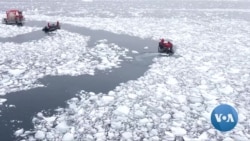ນ້ຳກ້ອນທະເລທີ່ຢູ່ອ້ອມຂົ້ວໂລກໃຕ້ ໄດ້ຫຼຸດລົງຈາກລະດັບສູງສຸດທີ່ເປັນປະຫວັດການ
ລົງສູ່ລະດັບຕ່ຳສຸດທີ່ເປັນປະຫວັດການໃນພຽງສາມປີ ອີງຕາມລາຍງານຄັ້ງໃໝ່ທີ່ໄດ້
ເປີດເຜີຍໃນອາທິດທີ່ຜ່ານມາ ໂດຍອົງການອະວະກາດ ສະຫະລັດ, NASA. ນັກຂ່າວ
ວີໂອເອ ເຟທ໌ ລາປີດັສ (Faith Lapidus) ລາຍງານວ່າ ນັກວິທະຍາສາດບໍ່ແນ່ໃຈ ວ່າ
ເປັນຍ້ອນຫຍັງ. ພຸດທະສອນ ມີລາຍລະອຽດມາສະເໜີທ່ານໃນອັນດັບຕໍ່ໄປ.
ໃນຂະນະທີ່ນ້ຳກ້ອນໃນມະຫາສະໝຸດ ອາກຕິກ ຢູ່ເໜືອສຸດຂອງໂລກໄດ້ເປື່ອຍຢ່າງບໍ່
ຢຸດຢັ້ງນັ້ນ, ວົງແຫວນຂອງນ້ຳກ້ອນທີ່ລອຍຢູ່ ຂອງຂົ້ວໂລກໃຕ້ ແມ່ນໄດ້ເພີີ່ມຂຶ້ນຢ່າງ
ຕໍ່ເນື່ອງ ຈົນຮອດປີ 2014.
ດຣ. ແຄຼ ພາກິນສັນ, ນັກວິທະຍາສາດ ກ່ຽວກັບ ໂລກ, ຈາກສູນກາງການບິນອະວະ
ກາດ Goddard ຂອງອົງການ NASA ກ່າວວ່າ “ໃນພຽງສາມປີເທົ່ານັ້ນ ຈາກປີ 2017
ມັນໄດ້ສ້າງປະຫວັດຕ່ຳສຸດໃນຮອບ 40 ປີ ແລະ ນັ້ນແມ່ນສິບລ້ານເຈັດແສນຕາລາງກິ
ໂລແມັດ. ສະນັ້ນລວມທັງໝົດ ໃນໄລຍະເວລາສາມປີ ມັນໄດ້ສູນເສຍນ້ຳກ້ອນໄປ 2,
ກາຍສອງລ້ານຕາລາງກິໂລແມັດໜ້ອຍນຶ່ງ ແລະ ມັນໃຫຍ່ກວ່າເນື້ອທີ່ຂອງປະເທດ
ເມັກຊິໂກ ໜ້ອຍນຶ່ງ.”
ນ້ຳກ່ອນທີ່ໄດ້ສ້າງຂຶ້ນດົນກວ່າສາມທົດສະວັດເຄິ່ງທີ່ຜ່ານມາ ຂອງຂົ້ວໂລກເໜືອໄດ້
ຫາຍໄປພາຍໃນພຽງສາມປີ.
ມີການເຫັນພ້ອມທາງວິທະຍາສາດວ່າ ການສູນເສຍນ້ຳກ້ອນທະເລ ໃນມະຫາສະໝຸດ
ອາກຕິກ ຫຼື ຂົ້ວໂລກເໜືອ ແມ່ນກ່ຽວຂ້ອງກັບ ອາກາດ ແລະ ນ້ຳທະເລທີ່ອຸ່ນຂຶ້ນ.
ບັນດານັກຄົ້ນຄວ້າ ກຳລັງຊອກຫາຄຳອະທິບາຍ ສຳລັບການຫຼຸດລົງຢ່າງ ຫຼວງຫຼາຍ
ຂອງນ້ຳກ້ອນໃນຂົ້ວໂລກໃຕ້.
ດຣ. ແຄຼ ກ່າວວ່າ “ຫຼັງຈາກປີ 2014 ຕອນທີ່ການລະລາຍຢ່າງຫຼວງຫຼາຍໄດ້ເກີດຂຶ້ນນັ້ນ
ມັນມີຄວາມພະຍາຍາມບາງຄັ້ງ ທີ່ຈະເອົາມັນໄປເຊື່ອມໂຍງກັບ ບາງຢ່າງທີ່ກຳລັງເກີດ
ຂຶ້ນຢູ່ເທິງຊັ້ນບັນຍາກາດ ຫຼື ມະຫາສະໝຸດ ແລະ ມັນໄດ້ມີສິ່ງທີ່ລະບຸໃຫ້ເຫັນວ່າ ບາງ
ເທື່ອຄືກັບທະເລ ເວັດແດລ (Weddell)ມັນອາດມີອາກາດອຸ່ນເຂົ້າມາຈາກພາກເໜືອ
ແລະ ໃນທະເລ ຣອສ໌ (Ross) ມັນອາດມີເຫດຜົນທີ່ແຕກຕ່າງກັນພຽງໜ້ອຍດຽວ.”
ບໍ່ວ່າຈະເປັນເຫດຜົນຫຍັງກໍຕາມ, ແນວໂນ້ມແມ່ນມີສິ່ງທີ່ພົວພັນຢ່າງກວ້າງຂວາງ ສຳ
ລັບລະບົບນິເວດຂົ້ວໂລກ ແລະ ໂລກທັງໝົດ. ບໍ່ຄືກັບພື້ນຜິວສະທ້ອນແສງທີ່ແຈ້ງຂອງ
ນ້ຳກ້ອນ, ນ້ຳສີເຂັ້ມ ຂອງມະຫາສະໝຸດຈະດູດຊຶມເອົາແສງຕາເວັນ, ກັກເອົາຄວາມ
ຮ້ອນໄວ້ ແລ້ວ ນຳໄປຢູ່ວົງຈອນຂອງການອຸ່ນຂຶ້ນຢ່າງຕໍ່ເນື່ອງ.
ບັນດານັກວິທະຍາສາດ ກຳລັງດຳເນີນການຄົ້ນຄວ້າໃນຂົ້ວໂລກໃຕ້, ຊອກຫາຄຳອະທິ
ບາຍ ແລະ ຂໍ້ແກ້ໄຂບັນຫາຢູ່.
The sea ice around Antarctica has plunged from a record high to a record low in just three years according to a new report released this week by the U.S, space agency NASA. Faith Lapidus reports scientists are not sure why.]]
While sea ice in the Arctic Ocean at the top of the world was steadily melting, Antarctica's ring of floating ice was steadily growing… until 2014.
"In just three years as of 2017 it reached its 40 year record low and that was 10.7 million square kilometers. So altogether in that period of three years it lost two, a little over two million square kilometers of ice and that's a little bit larger than the area of Mexico."
More than three and a half decades of Antarctica's ice gain vanished in just three years, melting more rapidly than what's happening in the Arctic.
The scientific consensus is that the loss of Arctic sea ice is related to both air andsea water getting warmer.
Researchers are still looking for an explanation for the dramatic decline in Antarctica.
"After 2014 when this huge decrease happened there are some attempts to try to relate it to something going on in the atmosphere or the oceans and there have been some indications that maybe like in the Weddell Sea it could have been warm air coming in from the north and in the Ross Sea it might have been slightly different reasons."
Whatever the reason, the trend has far-reaching implications for the polar ecosystem and the Earth as a whole. Unlike the bright reflective surface of ice, dark ocean water absorbs sunlight, trapping heat and leading to a cycle of continous warming.
Scientists are still doing research in Antarctica, looking for explanations, and solutions.





